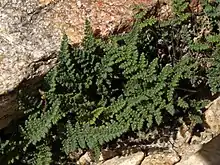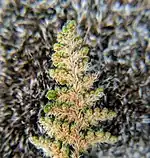Myriopteris intertexta
Myriopteris intertexta, formerly Cheilanthes intertexta,[1][2] is a species of lip fern known by the common name coastal lip fern. It is native to montane California and western Nevada, Oregon east of the Cascades, and with a disjunct population in central Utah. It grows in dry rocky habitats in sun, typically in rock cracks with little or no soil.
| Myriopteris intertexta | |
|---|---|
 | |
| Scientific classification | |
| Kingdom: | Plantae |
| Clade: | Tracheophytes |
| Division: | Polypodiophyta |
| Class: | Polypodiopsida |
| Order: | Polypodiales |
| Family: | Pteridaceae |
| Subfamily: | Cheilanthoideae |
| Genus: | Myriopteris |
| Species: | M. intertexta |
| Binomial name | |
| Myriopteris intertexta (Maxon) Grusz & Windham | |
| Synonyms | |
| |
Description
This fern produces clusters of dark green leaves up to about 25 centimeters long. Each leaf is divided into bumpy segments which are subdivided into pairs of rounded beadlike ultimate segments with their edges curled under to make them concave underneath. Each ultimate segment is less than 3 millimeters wide, sparsely hairy on top and scaly on the underside. Its sori are mostly hidden under the scales and curled leaflet margin (false indusium). The long-lanceolate scales on the underside of the leaflets are approximately 1 mm wide at their base, intermediate between those of its two parents (M. gracillima scales are very narrow (hair like) and those of M. covillei are 2–3 mm wide). The leaves arise from a short creeping rhizome, such that plants often have an elongated base, for example creeping along a rock crevice.[2]

Range
M. intertexta is found in Oregon, California, and eastern Nevada. In addition, there is an apparently disjunct population in north-central Utah on Mount Olympus in the Wasatch Range. The range of M. intertexta is intermediate between that of its two parents M. gracillima (with a range that extends further north) and M. covillei (with a range that extends further south and east into southern California, Arizona, and the Baja California peninsula and central Mexico).[2][3][4]
Taxonomy
This fern is thought to be an allotetraploid fertile hybrid of Myriopteris gracillima (maternal) and Myriopteris covillei (paternal).[2][5][6][1][7]
References
- Grusz & Windham 2013.
- Jepson: Myriopteris intertexta
- Jepson: Myriopteris gracillima
- Jepson: Myriopteris covillei
- Windham & Rabe 1993.
- Grusz, A. L., M. D. Windham, and K. M. Pryer. 2009. Deciphering the origins of apomictic polyploids in the Cheilanthes yavapensis complex (Pteridaceae). American Journal of Botany 96: 1636–1645
- Grusz et al. 2014.
Works cited
- Grusz, Amanda L.; Windham, Michael D. (2013). "Toward a monophyletic Cheilanthes: The resurrection and recircumscription of Myriopteris (Pteridaceae)". PhytoKeys (32): 49–64. doi:10.3897/phytokeys.32.6733. PMC 3881352. PMID 24399906.
- Grusz, Amanda L.; Windham, Michael D.; Yatskievych, George; Huiet, Lane; Gastony, Gerald J.; Pryer, Kathleen M. (2014). "Patterns of Diversification in the Xeric-adapted Fern Genus Myriopteris (Pteridaceae)" (PDF). Systematic Botany. 39 (3): 698–714. doi:10.1600/036364414X681518. JSTOR 24546228.
- Kirkpatrick, Ruth E.B.; Smith, Alan R.; Lemieux, Thomas; Alverson, Edward, eds. (2014). "Myriopteris intertexta". Jepson eFlora, Revision 2. Jepson Flora Project. Retrieved November 12, 2022.
- Windham, Michael D.; Rabe, Eric W. (1993). "Cheilanthes intertexta". In Flora of North America Editorial Committee (ed.). Flora of North America North of Mexico. Vol. 2: Pteridophytes and Gymnosperms. New York and Oxford: Oxford University Press. Retrieved October 3, 2022.
External links
- Calflora Database: Myriopteris intertexta (Coastal lip fern) — formerly Cheilanthes intertexta.
- Jepson Manual eFlora (TJM2) treatment of Myriopteris intertexta — formerly Cheilanthes intertexta.
- USDA Plants Profile for Cheilanthes intertexta (coastal lip fern)
- UC Photos gallery — Cheilanthes intertexta